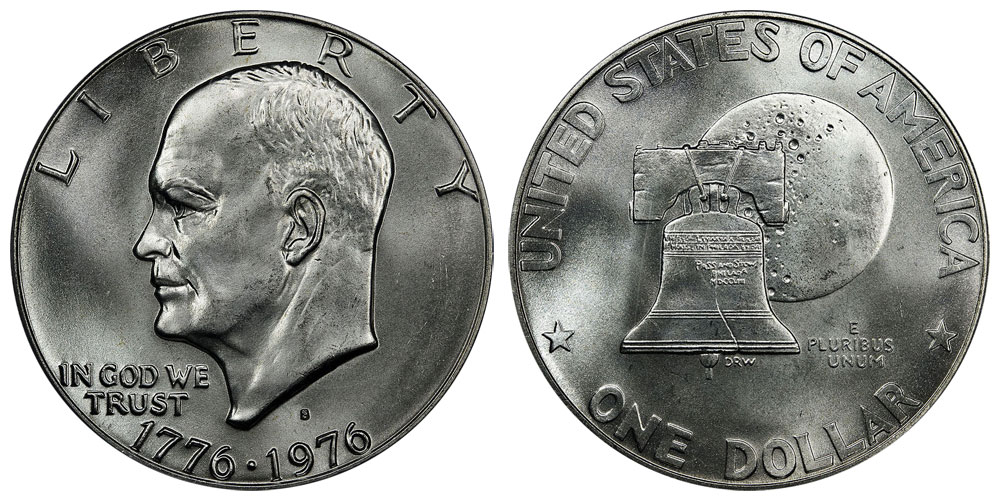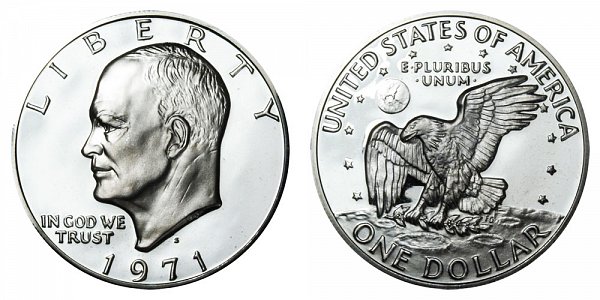1971 Silver Dollar Value
- Uncirculated Eisenhower Coin 1971
- 1971 Silver Dollar Value
- 1971 Silver Dollar Value D Mint
- 1971 Silver Dollar Value No Mint Mark
If you're looking for an Eisenhower dollar price guide and don't want to read the full article, click the link or scroll down.
In previous articles, we've explained how to value earlier series of U.S silver dollars, like Morgan and Peace Dollars (minted 1878-1935) as well as Trade Dollars(1873-1885). In today's article, we're going to discuss a more modern dollar coin — the Eisenhower Dollar, minted from 1971-1978.
- USA Coin Book Estimated Value of 1971-S Eisenhower Dollar (Silver Clad Variety) is Worth $17 or more in Uncirculated (MS+) Mint Condition. Proof coins can be worth $19 or more. Click here to Learn How to use Coin Price Charts. Also, click here to Learn About Grading Coins.
- Details, specifications, values and general information for the 1971 Elizabeth II Canadian Silver Dollar (British Columbia). Also find this coin and many others at the best prices.
The 1971-D Friendly Eagle dollar, which may number about 500,000 pieces, is a scarce and widely collected variety. Values range from about $25 for a typical circulated specimen to $40 or much higher for uncirculated examples. 1971-S Peg Leg Dollar Variety. CoinTrackers.com has estimated the 1971 Eisenhower Dollar value at an average of $2, one in certified mint state (MS+) could be worth $85.

History of the Eisenhower Dollar
Originally struck from 1971 to 1978, Eisenhower Dollars (or 'Ikes') were the first large-size dollar coins to be produced by the U.S. Mint since the end of the Peace Dollar series in 1935.
As you might guess from the name, Eisenhower Dollars were created to commemorate President Dwight Eisenhower, whose portrait is featured on the obverse (front) side of the coin.
Eisenhower was selected in part because of his political party affiliation. Republicans in Congress agreed that the Mint needed a coin commemorating a Republican president, as the Democrats had recently secured a spot for President Kennedy on the half dollar (replacing Benjamin Franklin).
The coin's reverse features the Apollo 11 insignia, an eagle landing on the moon while grasping an olive branch, in commemoration of the first Apollo mission moon landing in 1969. The coin's designer, Frank Gasparro, was ordered to change his original design of the eagle because it was 'too fierce and too warlike', and reluctantly updated it to make the eagle look friendlier.
Unlike Peace Dollars and Morgan Dollars, Eisenhower dollars were minted in a copper-nickel alloy rather than a 90% silver 10% copper alloy.
By the 1970's, silver prices had risen to the point where striking general circulation coins from silver was no longer cost-effective. Prior to 1965, all dimes, quarters, half dollars and dollars coins were produced in a 90% silver 10% copper alloy. This proved a point of contention for Congress—several congressmen argued that producing the new dollar coin in copper-nickel instead of silver would be a dishonor to Eisenhower's memory.
But eventually a compromise was reached. All Eisenhower Dollars produced for general circulation would be struck in copper-nickel, while the Mint would also sell dollar coins with a special 40% silver alloy to collectors for a small premium.
As a result, most Ikes aren't true 'silver dollars.' But the upside of that is that Eisenhower dollars are much more affordable than their 90% silver predecessors.
Uncirculated Eisenhower Coin 1971
There are two different reverse designs within the Eisenhower series. From 1971 to 1974 and from 1977 to 1978, the Apollo 11 design was used for the coin's reverse. But in 1976, all quarters, half dollars, and dollar coins were switched to a special design commemorating the nation's bicentennial. The 1776-1976 Eisenhower Dollar featured the Liberty Bell superimposed upon the moon.
1971 Silver Dollar Value
Free Download - Our 20-page Beginner's Guide to Coin Collecting
Follow the link above to receive our free 20-page PDF guide to coin collecting, including:
- 5 Rules Every Collector Should Know
- Where to Buy and Sell Coins
- How to Determine Coin Value
- How to Avoid Getting Ripped Off
- How to Grade Coins
Values
(Values derived from the Red Book, the definitive price guide for U.S. coins).
Circulated Condition means a coin with signs of wear or marks, from being circulated/used by the general public.

Uncirculated Condition means a coin with bright original mint luster and no signs of wear. See the picture below for a visual comparison of the two.
As you can see, most Eisenhower dollars are readily available and are worth little more than face value. However, there are a few more valuable coins that are well worth keeping an eye out for.
Rare Eisenhower Dollars
While all Ikes intended for general circulation were struck in copper-nickel, the U.S. Mint also struck a number of S-mintmark coins (produced at the San Francisco mint) for collectors in 40% silver (each containing 1/3rd ounce pure silver). Not all S-mint Ikes are silver though, as the 1977-S and 1978-S Eisenhower dollars were both produced in copper-nickel.
The silver coins can be identified by their lighter color (see copper-nickel vs silver). A simple way to determine whether your Ike is silver or copper-nickel is the tissue test, as demonstrated below.
Simply place a facial tissue on top of your dollar coin and see whether the color that shines through is darker or lighter. The coin on the left is silver-clad, whereas the darker one on the right is copper-nickel.
There is also one copper-nickel coin variety that commands a premium. The rare 1972 'Type 2' design variety with no mintmark is worth upwards of $30 in all conditions. Type 2 dollars are identified by the details of Earth, above the eagle on the reverse side of the coin. Next to the outline of Florida there are no distinguishable islands on Type 2 Ikes. On the less valuable Type 1 and Type 2 1972 dollars, there are distinct islands in the Caribbean. No other years in the Eisenhower Dollar series besides the 1972 feature the rare Type 2 design.
Here's a picture to illustrate the difference - note the small islands visible within the red circles on the Type 1 and Type 3 coins, while the Type 2 coin shows no distinct islands.
The Type 2 design is rough and undefined, with a barely distinguishable outline of the east coast, while small dots/islands can be spotted off the coast of Florida on the Type 1 and Type 3 designs. This can be tough to spot, so make sure you're using a magnifying glass or a jeweler's loupe to be sure.
:max_bytes(150000):strip_icc()/US0100-1979-Susan-B-Anthony-Dollar-lg-58a4c6a95f9b58a3c9433858.jpg)
1971 Silver Dollar Value D Mint
Outside of the 1972 Type 2 and the silver Ikes, there are no real rarities within the series. Proof coins, specially produced by the U.S. Mint with mirrored surfaces and sold to collectors, are generally only worth a small premium.
But the lack of keydates means that a nice set of Eisenhower Dollars is easily attainable no matter what your budget.
Last updated 8/7/2018